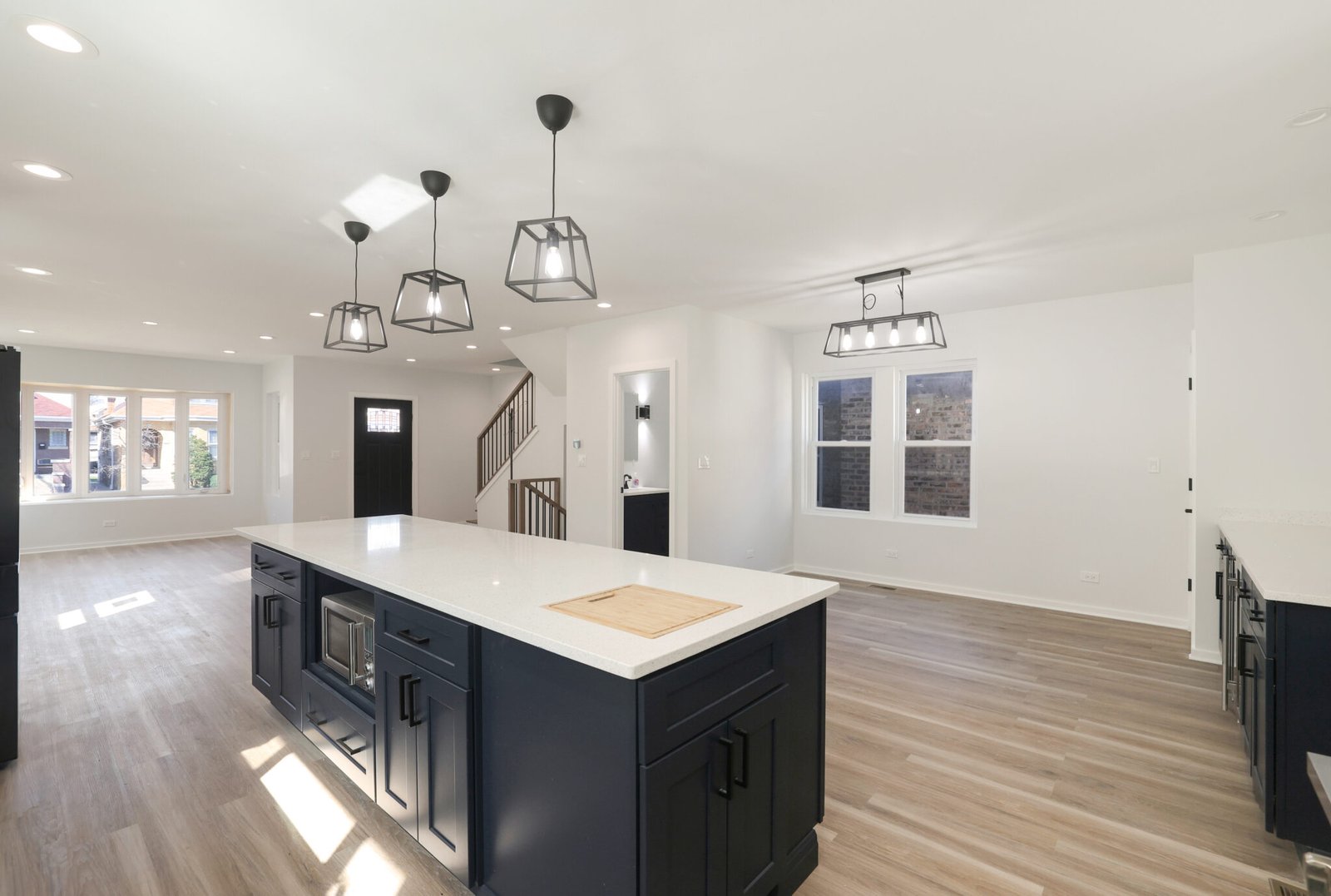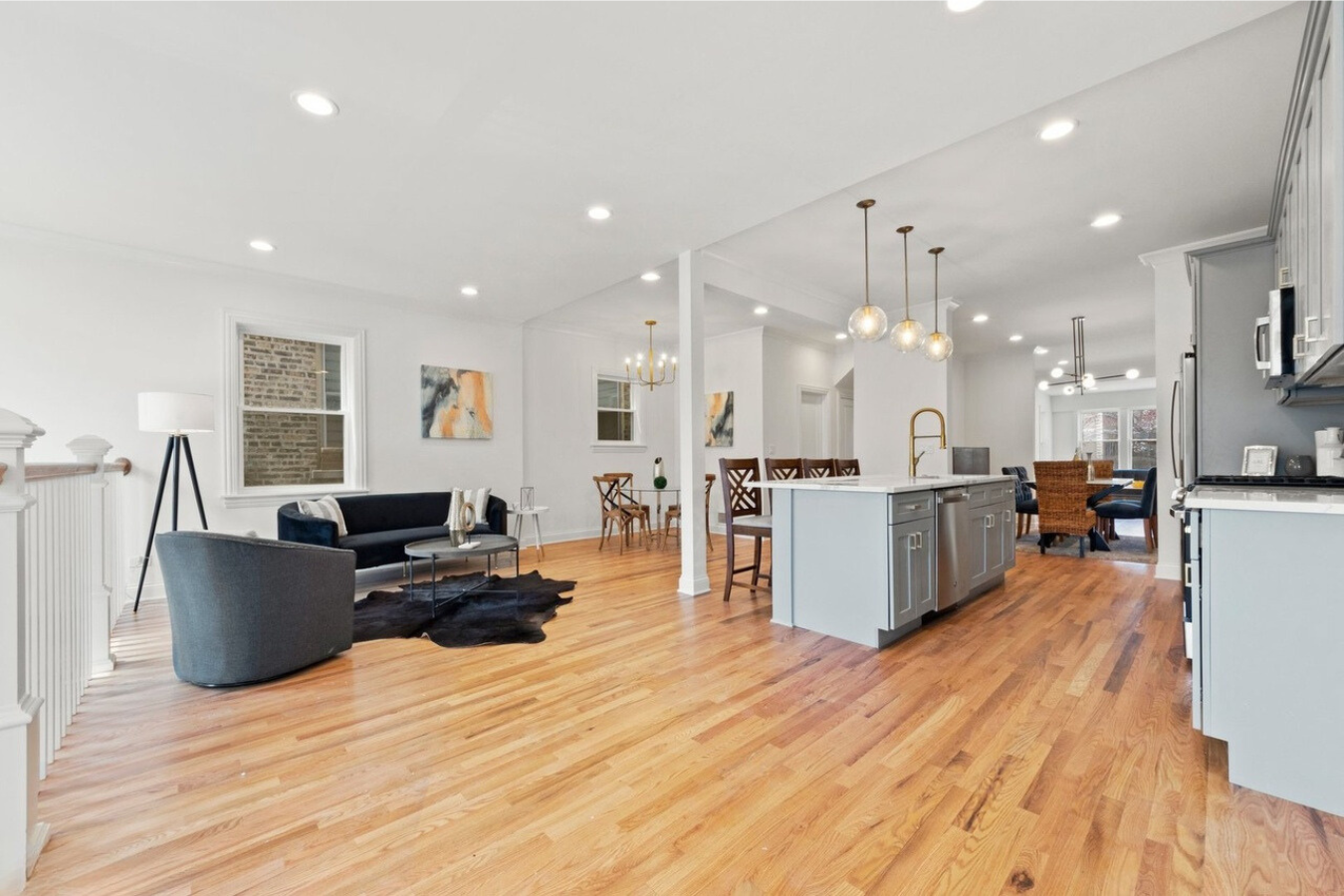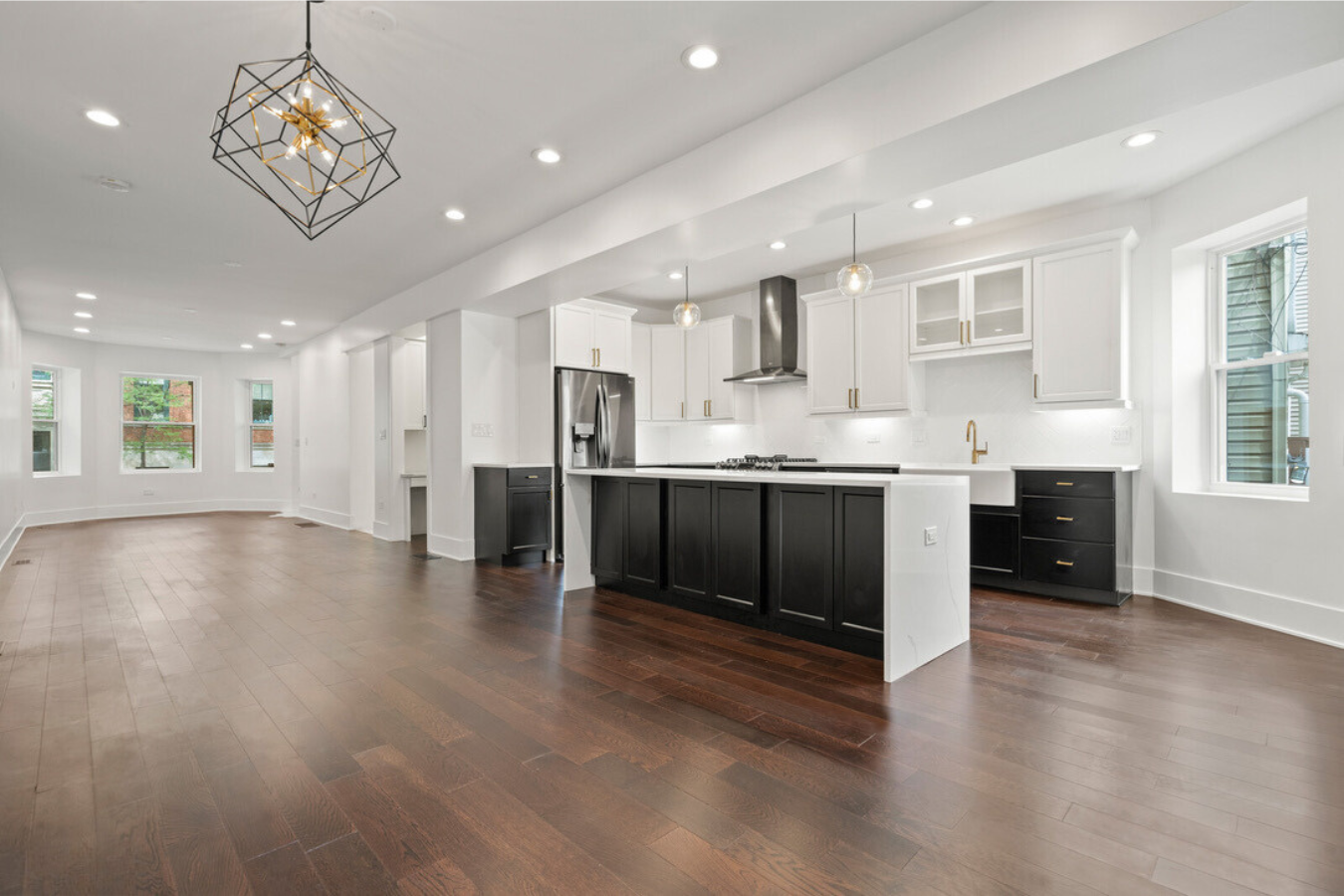
6 Cost-Saving Kitchen Remodeling Strategies – Maximize Your Home Improvement Budget
Renovating your kitchen can be a significant investment, but with the right approach, you can achieve a beautiful, functional space without breaking the bank. In today’s competitive home improvement market, design/build remodeling contractors like Pegasus Construction help homeowners make informed decisions by strategically planning budgets, sourcing affordable materials, and optimizing layout efficiency. In this comprehensive guide, you’ll discover six proven strategies to remodel your kitchen on a budget while enhancing its functionality and aesthetic appeal. Whether you’re considering upgrading your countertops to granite or quartz, installing modern lighting such as pendant or recessed fixtures, or simply rethinking your kitchen layout for efficiency, these cost-saving techniques will guide you through every step of the remodeling process.
A well-planned kitchen remodel begins with establishing a realistic budget that not only outlines your expenses but also highlights where you can maximize savings. Understanding your financial limitations can help prioritize upgrades with the greatest impact, such as switching out outdated cabinetry or updating your flooring with durable yet affordable options like laminate or tile. With over 20 years of experience, Pegasus Construction has helped numerous Chicago homeowners find cost-effective solutions—from installing IKEA kitchen cabinetry to implementing expert DIY installation techniques—that result in long-lasting quality and enhanced home value. As you read on, each section will answer key questions about setting budgets, sourcing economical supplies, rethinking your layout, and leveraging DIY techniques without compromising on style or safety.
The strategies discussed herein are data-driven and supported by industry insights and reputable research. You’ll learn how to balance high-end finishes, such as stainless steel appliances and butcher block countertops, with more modest alternatives like spray-painted laminate or reclaimed wood for a farmhouse vibe. From understanding the impact of electrical wiring and lighting design on your remodel cost to accessing community resources and expert guidance, these six strategies empower you to take control of your kitchen remodel while boosting the overall return on your investment. Let’s explore these six actionable items that form the cornerstone of an efficient, budget-friendly
.
1. Establishing a Budget That Maximizes Savings – How Can You Strategically Plan Your Remodeling Costs?

The first step toward a successful kitchen remodel is developing a detailed budget that maximizes your savings. Begin by analyzing your current expenses and estimating the costs of materials, labor, and unexpected contingencies. A clear budget not only sets spending limits on high-cost areas like full kitchen remodels or custom cabinetry but also highlights opportunities to save on smaller projects such as updating light fixtures or reconfiguring a galley kitchen layout.
Start by listing major cost drivers: – Cabinetry and Countertops: Opt for alternatives to expensive granite, such as quartz or reclaimed wood, while still achieving a high-end look. – Flooring and Backsplash: Consider cost-efficient options like laminate flooring or ceramic tile that deliver durability and aesthetic appeal. – Lighting and Fixtures: Energy-efficient LED lighting, including pendant lights and recessed fixtures, can lower long-term utility costs. – Labor and Permits: Factor in the cost of hiring licensed electricians or contractors while seeking free consultation sessions offered by reputable companies like Pegasus Construction.
For example, using a detailed spreadsheet, you might allocate 40% of your total budget to cabinetry and countertops, 20% to appliances and fixtures (stainless steel ranges and ovens), 25% to labor and installation (including demolition and electrical work), and 15% to miscellaneous expenses and contingency funds. Research shows that homeowners who plan their budgets comprehensively can reduce overall kitchen remodel costs by up to 25% compared with those who do not (HomeAdvisor, 2021).
By establishing a realistic budget, you lay the groundwork for a remodel that balances quality with affordability, ensuring that every dollar spent contributes toward a better-designed kitchen.
2. Sourcing Affordable Materials and Supplies – What Strategies Help You Find Cost-Effective Options?

One of the most effective ways to reduce your overall kitchen remodel cost is by sourcing affordable materials without sacrificing durability or style. The market today is brimming with options ranging from high-end marble and custom oak cabinetry to more economical, equally attractive alternatives such as laminate flooring, butcher block countertops, and engineered wood cabinet fronts.
Key sourcing strategies include:
- Bulk Purchasing and Clearance Sales: Look for deals at surplus stores and home materials outlets. For example, purchasing lumber, drywall, crown molding, or even stainless steel sinks in bulk often results in significant discounts.
- Local Suppliers and Reclaimed Materials: Utilizing locally sourced materials can reduce shipping costs and support local businesses. Reclaimed wood and recycled tile not only offer character to your kitchen remodel but also align with sustainable practices.
- Comparison Shopping: Utilize online tools and contractor networks (like those provided by Pegasus Construction) to compare prices among different suppliers. Consider options such as discount home improvement chains that offer quality products at a fraction of standard market rates.
- DIY Material Finishing: When possible, use DIY techniques to update existing elements. For instance, spray paint can be used to refresh dated countertops or old laminate cabinet fronts, reducing the need for costly replacements.
Real-World Example: Many Chicago homeowners have achieved a stylish kitchen remodel by mixing new elements with repurposed items. One client managed to reduce costs significantly by reusing existing baseboards and repurposing leftover lumber for shelving, while investing savings into energy-efficient lighting upgrades and a modern induction cooktop.
Below is a table summarizing key material options compared by cost-effectiveness, durability, and design appeal:
| Material Option | Cost-Effectiveness | Durability Level | Design Appeal | Typical Application |
|---|---|---|---|---|
| Quartz Countertops | Moderate | High | Modern, sleek | Kitchen islands, countertops |
| Butcher Block | High | Moderate | Warm, rustic | Cutting surfaces, worktops |
| Laminate Flooring | High | Moderate | Versatile, contemporary | Overall kitchen flooring |
| Reclaimed Wood | Very High | Moderate | Vintage, sustainable | Cabinetry accents, shelving |
| Ceramic Tile | Moderate | High | Classic, timeless | Backsplashes, floor borders |
This strategic material sourcing not only supports your budget but also enhances the overall look and function of your kitchen remodel.
3. Rethinking Kitchen Layout for Efficiency and Cost Savings – How Does an Optimized Layout Save Money?

Optimizing your kitchen layout can lead to significant cost savings by improving workflow efficiency and reducing the need for extensive structural changes. A well-planned floor plan minimizes unnecessary electrical wiring adjustments, plumbing modifications, and labor costs typically associated with demolition and reconstruction.
Consider these key elements when rethinking your kitchen layout:
- Efficient Work Triangle: Ensure that the sink, stove, and refrigerator form an efficient triangle. This classic layout reduces wasted space and keeps daily tasks streamlined, thereby enhancing productivity in the kitchen.
- Open Concept Spaces: Where possible, removing or reducing fixed barriers like walls or bulky cabinets can create an open-concept layout that maximizes natural light and circulation. This not only modernizes the space but may also eliminate the need for costly structural permits or additional demolition.
- Multipurpose Islands and Countertops: Designing a kitchen island that includes prep space, storage, and seating transforms your kitchen into a functional hub, reducing the need for additional dining areas or separate workspace installations.
- Storage Optimization: Custom-designed cabinetry that maximizes vertical space, pull-out drawers for utensils, and integrated pantry solutions can reduce clutter while improving accessibility and efficiency. Even small changes, like replacing standard drawer interiors with custom organizers, can significantly impact everyday functionality.
A prime example of layout efficiency is the ‘galley’ kitchen design, which maximizes narrow spaces by organizing key functions along opposing walls. In fact, studies indicate that restructuring your kitchen layout to embrace an open-concept can reduce remodeling time by up to 15% (Remodeling Magazine, 2021). Choosing a layout that aligns with your cooking habits and space constraints not only improves functionality but also increases the overall market value of your home.
4. Implementing Cost-Smart DIY Installation Techniques – How Can DIY Methods Lower Remodeling Costs Safely?

Taking on DIY installation projects can drastically cut remodeling costs by reducing labor expenses while giving you creative control over your home renovation. However, it is essential to know which tasks can be safely handled by a determined homeowner and which require a professional.
Cost-smart DIY strategies include:
- Painting and Finishing: If you have a steady hand and patience, spray painting cabinets, walls, or even outdated light fixtures can refresh the kitchen’s look with minimal investment. Using primer and quality brush techniques ensures a long-lasting finish on surfaces like drywall or laminate.
- Installing Flooring and Backsplash: Many homeowners successfully install laminate flooring or ceramic tile backsplashes with the help of online tutorials and proper tools such as a miter saw, notched trowel, and utility knife. These projects typically save on labor costs without sacrificing quality.
- Lighting Upgrades: Replacing outdated light fixtures with modern pendant lights or LED recessed fixtures can be a straightforward task if you follow safety guidelines. While electrical wiring, especially involving new circuits or heavy-duty fixtures, should be left to licensed electricians, swapping out bulbs or replacing outdated lamps is well within the DIY realm.
- Cabinet Refresh and Drawer Upgrades: Instead of replacing kitchen cabinets entirely, consider refinishing, repainting, or updating hardware like knobs and pulls. Upgrading drawer organization with pull-out trays or custom inserts is also a manageable project that can dramatically improve functionality.
Before embarking on any DIY project, assess your skill level and ensure you have the proper tools and safety equipment. Many local home improvement stores offer free workshops or advice sessions, which can be invaluable when dealing with challenging tasks like electrical updates or precise carpentry work. Utilizing community resources and online tutorials can transform a seemingly daunting project into a cost-effective, rewarding experience.
5. Prioritizing Upgrades With the Greatest Impact – Which Kitchen Improvements Offer the Most Value?

When working with a limited budget, it is crucial to focus on upgrades that provide the highest return on investment. Not every detail demands a premium finish; some changes can dramatically elevate your kitchen’s overall functionality and aesthetic appeal without a high price tag. Focus on improvements that both boost your home’s market value and enhance daily living.
High-impact kitchen upgrades include:
- Energy-Efficient Appliances: Upgrading to energy-efficient stainless steel refrigerators, ovens, or dishwashers reduces utility bills and appeals to environmentally conscious buyers. Even if the initial investment seems high, the long-term savings and increased resale value make it worthwhile.
- Modern Lighting and Fixtures: Installing energy-efficient LED lighting throughout the kitchen not only creates a warm, inviting atmosphere but also improves functionality. Updating outdated fixtures, such as pendant lights or recessed lighting, can transform the space in an instant.
- Countertops and Backsplashes: New countertops made from affordable yet durable materials like quartz or engineered stone, paired with eye-catching backsplashes (tile or even peel-and-stick options), can become the centerpiece of your kitchen remake.
- Cabinet Upgrades: Instead of replacing cabinets entirely, consider refacing them or simply changing the hardware. This approach can update the look of your kitchen at a fraction of the cost while maintaining the existing structure.
- Flooring Improvements: Upgrading floor surfaces to cost-effective yet appealing alternatives like laminate or vinyl tile can have immediate aesthetic benefits and improve durability, especially in high-traffic areas.
For example, many homeowners have reported that by prioritizing energy-efficient appliance upgrades and modern lighting installations, they saw an immediate 30% boost in both functional performance and visual appeal. These changes not only create a more enjoyable space but also increase the overall value of your home when it comes time for resale.
Below is a table that compares typical upgrades by cost, impact, and return on investment (ROI):
| Upgrade Type | Approximate Cost Range | Impact on Functionality | Estimated ROI (%) |
|---|---|---|---|
| Energy-Efficient Appliances | $2,000 – $10,000 | High | 60–80 |
| Modern Lighting & Fixtures | $500 – $3,000 | High | 50–70 |
| Cabinet Refacing/Hardware | $1,000 – $5,000 | Moderate | 40–65 |
| New Countertops & Backsplash | $1,500 – $7,000 | High | 55–75 |
| Flooring Upgrades | $1,000 – $4,000 | Moderate | 40–60 |
Prioritizing these upgrades ensures that your available budget is allocated to the areas that will have the most significant impact in both everyday use and long-term home value.
6. Accessing Expert Guidance and Community Resources – How Can Professional Support Accelerate Your Remodel?

Even the most dedicated DIY enthusiast benefits from professional guidance, ensuring that your remodel stays on schedule, within budget, and compliant with local building codes. Expert consultation from a reputable design/build remodeling contractor like Pegasus Construction can provide invaluable insights into optimizing your kitchen remodel and accessing community resources that further reduce costs.
Advantages of professional support include:
- Accurate Cost Estimations and Planning: Contractors with decades of experience are familiar with market trends, pricing, and potential pitfalls. They provide detailed project estimates and budgeting advice that can prevent costly overruns.
- Efficient Project Management: Leveraging expert project management ensures that all aspects—from electrical wiring and plumbing to cabinet installation and tile work—are coordinated smoothly. This reduces downtime, avoids redundant work, and keeps your remodel on track.
- Access to Trade Discounts: Professional contractors often have established networks and relationships with suppliers. These connections can secure discounts on materials like carpeting, crown molding, or even custom kitchen cabinetry that the average homeowner might not access.
- Compliance and Safety: Professionals ensure that all work adheres to local building and safety codes. From installing proper electrical wiring for a new range hood to ensuring that countertops are securely anchored, their expertise minimizes risks and increases the longevity of your remodel.
- Community Resources and Workshops: Many local home improvement centers and community organizations offer free or low-cost workshops on DIY improvements, material selection, and safety practices. Tapping into these resources can provide additional savings and enhance your remodeling skills.
For instance, in Chicago, Pegasus Construction offers free consultations that help homeowners weigh the cost-benefit analysis of their remodeling options, from full kitchen remodels down to focused updates such as refining your kitchen layout. Their team not only assists with design insights but also manages the complex process of acquiring necessary permits and ensuring quality craftsmanship on every project.
Accessing reliable expert guidance and community resources ensures that even if you choose a DIY approach for some aspects of your kitchen transformation, you have a solid backup plan for technical challenges. This blend of professional support and hands-on involvement leads to successful project outcomes that are cost-effective, timely, and reliable.
Final Thoughts

In summary, a cost-effective kitchen remodel hinges on careful planning and strategic decision-making. Establishing a realistic budget, sourcing affordable yet durable materials, and rethinking kitchen layout for efficiency can significantly reduce overall costs. Implementing DIY techniques where feasible, prioritizing high-impact upgrades, and leveraging expert guidance ensures a remodeling project that meets your aesthetic and functional needs while maximizing your investment. With these six strategies, you can transform your kitchen into a modern, efficient space without compromising quality or overspending.
Frequently Asked Questions

Q: How do I start planning a budget for my kitchen remodel? A: Begin by listing all major expense areas, such as cabinetry, countertops, flooring, and labor costs. Create a detailed spreadsheet to outline your expenses and allocate funds for contingencies. This will help you set clear priorities and avoid overspending.
Q: What are some affordable material options for kitchen remodeling? A: Consider materials like quartz or butcher block for countertops, laminate or ceramic tile flooring, and reclaimed wood for cabinetry accents. These options provide durability and style at a lower cost compared to high-end materials like marble or custom oak.
Q: Can I safely handle any kitchen remodel tasks myself? A: Yes, many tasks such as painting, installing laminate flooring, or updating cabinet hardware can be done by homeowners with the right tools and guidance. However, complex tasks involving structural changes or electrical wiring should be performed by professional contractors.
Q: Which kitchen upgrades typically offer the highest return on investment? A: Energy-efficient appliances, modern lighting, and updated countertops and backsplashes usually provide the most significant boost in functionality and home value. These improvements enhance the kitchen’s performance and can recoup a substantial portion of the renovation costs upon resale.
Q: How do professional contractors add value to a kitchen remodel project? A: Professionals like Pegasus Construction offer expert planning, project management, and access to trade discounts that can reduce costs and ensure compliance with building codes. Their support helps streamline the project and guarantees a quality outcome that maximizes your overall investment.
Q: Is it worth investing in community resources and workshops for DIY projects? A: Absolutely. Local workshops and expert-led consultations not only provide practical skills but also offer cost-saving tips and safety guidelines. These resources can improve your confidence and efficiency in handling DIY projects, ultimately lowering your remodeling expenses.
Key Takeaways

- A detailed budget is crucial to maximize savings and direct funds to high-impact areas.
- Sourcing affordable materials through bulk purchasing, reclaimed options, and local suppliers leads to considerable cost reductions.
- Optimizing your kitchen layout improves functionality while reducing unnecessary remodeling expenses.
- DIY installation techniques can effectively lower labor costs, provided safety and quality are maintained.
- Prioritizing upgrades like energy-efficient appliances and modern lighting delivers high returns on investment.
- Professional guidance from experienced contractors can streamline the remodel process and access additional savings through expert networks.
Final Thoughts

A well-executed kitchen remodel requires a balanced blend of careful budgeting, smart sourcing, and efficient layout planning. By focusing on cost-saving techniques and prioritizing upgrades that offer the most value, you can create a kitchen that is both beautiful and functional. Leveraging DIY methods alongside professional guidance further ensures that your project remains on track and within budget. Ultimately, these strategies not only enhance your daily cooking experience but also significantly boost your home’s overall value and appeal.





